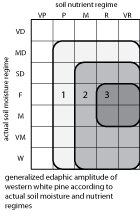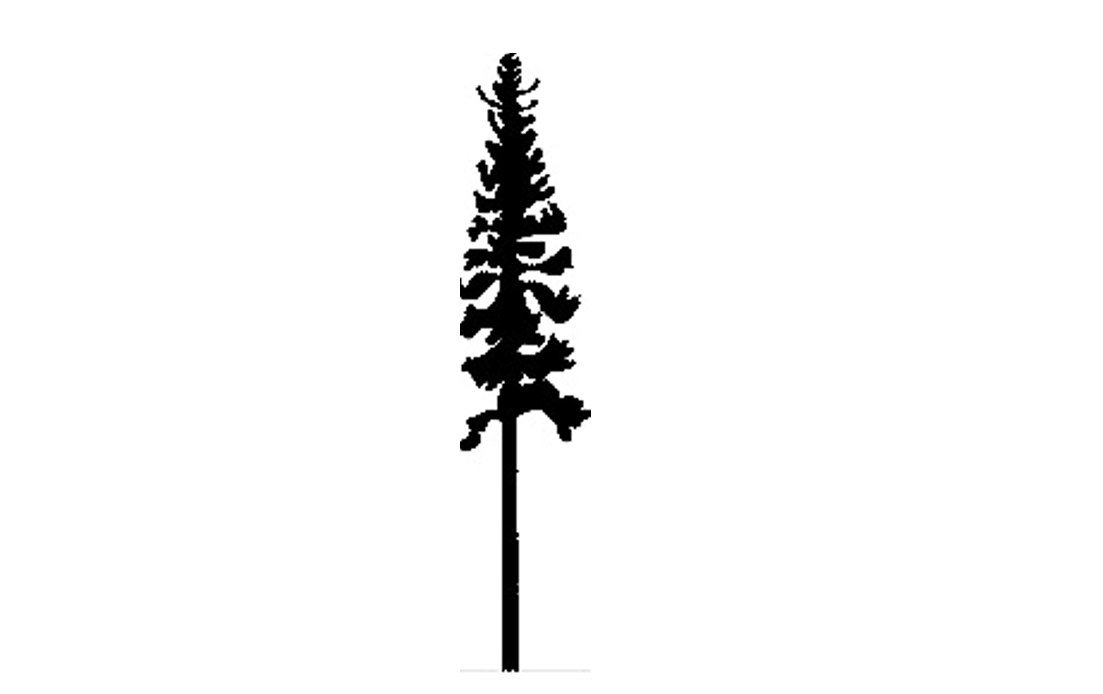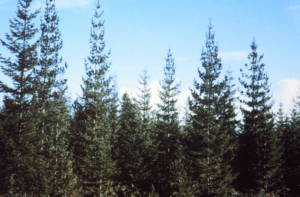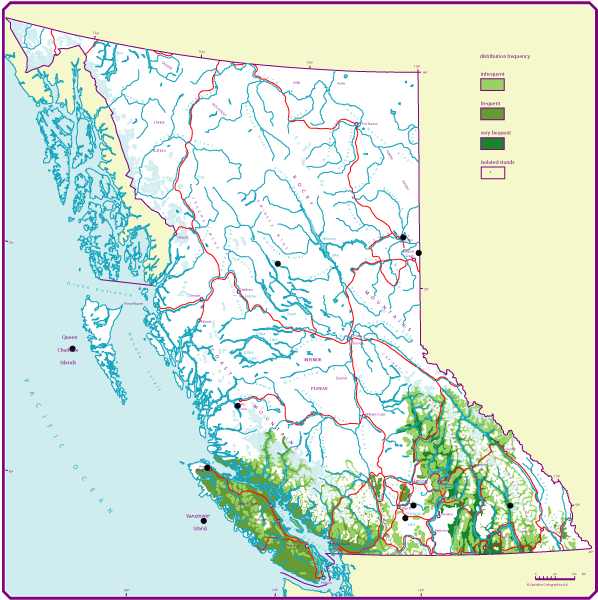Western white pine
On this page
Geographic range and ecological amplitudes
Description
Western white pine is a medium- to large-sized (exceptionally >70m tall) evergreen conifer. At maturity, it has a sparse, variable crown, short branches (except for cone bearing branches which are long), and dark gray bark broken into small, scaly plates. It is an important timber species; its wood is desired for sash, frames, doors, interior paneling, building construction, match wood, and other products.
Geographic range
Geographic element:
Western North American/mainly Cordilleran and less Pacific
Distribution in Western North America:
central and (south) in the Pacific region, central and south in the Cordilleran region
Ecological amplitudes
Climatic amplitude:
subalpine boreal - cool temperate - cool mesothermal
Orographic amplitude:
submontane - montane - subalpine
Occurrence in biogeoclimatic zones:
(lower southern MH), (lower southern ESSF), MS, wetter IDF, ICH, (CDF), CWH
The tolerance of western white pine for dry and cold climates is lower than that of interior common Douglas. However, western white pine occurs in the lower, southern MH and ESSF zones.
Edaphic amplitude

Range of soil moisture regimes:
(moderately dry) - slightly dry - fresh - moist - very moist - wet
Range of soil nutrient regimes:
(poor) - medium - rich - very rich; calciphytic
Western white pine does not grow in very acid peat bogs, but it may grow on wet sites that are slightly acidic to neutral (e.g., skunk cabbage sites).
Western white pine grows well in calcium-rich soils or on seepage sites. It was found experimentally that the requirements of western white pine for calcium and magnesium are fairly high (Krajina 1969). When deprived of calcium, western white pine is first affected strongly by calcium dieback of its root system. Western white pine does not readily develop new roots when the older roots are killed. Therefore, calcium deficiency becomes a strong factor in the survival of western white pine.
Many young western white pine trees are eliminated in strongly leached calcium-poor soils, such as in the CWH zone. In the ICH zone, this elimination takes place when trees are much older and is therefore more easily noticed. When the trees (i.e., their roots) are already affected by calcium deficiency, they may be readily killed by drought. Plants experimentally inflicted with calcium deficiency frequently appear to wilt, even when water is available. In other cases of calcium deficiency, western white pine collapses more slowly - from the top of the crown down - by a process of chlorosis and later necrosis.
Tolerances and damaging agents
Root system characteristics
Approximately 65 percent of the total root system occurs in the uppermost 30cm of soil. The root system of mature trees can spread 8 m laterally from the root collar with verticals descending off the lateral system. Roots of western white pine are associated with both ecto- and endo-mycorrhizae.
| Tolerance to | Tolerance class | Comments |
|---|---|---|
| low light | M | variable; tolerance increases from perhumid to subhumid climates |
| frost | M - H | intermediate in coastal populations, high in interior populations |
| heat | M | absent or very sporadic in CDF and IDF |
| water deficit | L | following a long drought, pole blight may occur |
| water surplus | H | tolerates wet sites and inundation well |
| nutrient (mainly N) deficiency | L | sensitive to calcium deficiency |
| Damaging agent | Resistance class | Comments |
|---|---|---|
| snow | H | tolerates heavy snowpack |
| wind | M | increasing with increasing age |
| Risk class | ||
|---|---|---|
| fire | M - H | intermediate in coastal populations, high in interior populations |
| insect | M | mountain pine beetle, pine engraver |
| fungi | H | white pine blister rust; root and butt rots not a major concern (for example, red ring rot, Armillaria root disease, annosus root and butt rot, Schweinitzii butt rot) |
Associated tree species and successional role
In British Columbia, western white pine grows predominantly in even-aged, post-fire, mixed-species stands with a variety of species, and usually persists to late seral stages. It associates as a scattered species with a great number of species such as: Pacific silver fir, Grand fir, Subalpine fir, Western larch, Engelmann spruce, Common douglas, Western redcedar, and Western hemlock. It is present in early, mid-, and late stages of secondary succession; a minor component in the old-growth stands in cool temperate and mesothermal climates.
Genetics and notes
Genetics
Western white pine is different in genetic variation from most of other conifers. There is little geographical or ecological variation in western white pine populations. Work on blister rust indicated considerable heritability of resistance.
Notes
Western white pine is a very productive and desirable species considering its rapid growth, clean bole with minimum taper, narrow crown, and non-resinous wood. The major hazard limiting its wider application is blister rust. More detailed silvics information is given by:
Graham, R.T. 1990. Pinus monticola. Pp. 385-394 in R.M. Burns and B.H. Honkala (technical coordinators) Silvics of North America, Vol. 1. Agri. Handbook 654, USDA For. Serv., Washington, D.C.

This is the general shape and outline of the western white pine.

Naturally established western white pine outgrowing common douglas in the Drier Maritime CWH subzone on Southern Vancouver Island.

